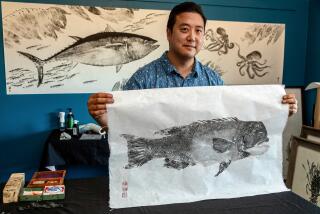Fisherman’s Friend : Munoz Provides Replica of Your Catch, or What You Tell Him You Caught
Every fisherman dreams of catching a trophy fish, one he can put on a wall to support his tales of angling prowess. That’s a fundamental truth of fishing.
Another fundamental truth: Fishermen lie.
“We get that all the time,” says Robert Munoz, who owns Robert’s Fish Mounts in Baldwin Park, providing fishermen fiberglass replicas of their alleged catches.
“With this catch-and-release thing, more and more people are releasing--but we don’t know if they’re catching,” Munoz says.
The state of the taxidermist’s art has progressed to the point where Munoz doesn’t need a fish to duplicate it. Hardly anyone orders a “skin” mount of a catch anymore, using the real fish. They don’t keep as well as plastic.
“It doesn’t matter what you do with them,” Munoz says. “If you hang it way up high where the heat accumulates, it’s cooking.”
The best advice is not to bother. Just tell Munoz you caught, say, a 15-pound largemouth bass. He’ll take your word for it and pull a mold off the shelf for a reproduction so true after he finishes painting it that even the fish’s mother wouldn’t know the difference. Whether the angler caught such a fish is not Munoz’s concern.
“We’re not in the record-keeping business,” he says.
You want a 600-pound marlin? A two-inch pet goldfish? Phone orders accepted, $10 an inch, with a minimum charge of $200. Munoz, 41, has built up such an inventory of molds during the last 18 years that he can make up stocks of trophy fish yet to be caught.
“We’re making up some now, with the opening of trout season coming,” he says. “It’s getting so we can predict what will be caught.”
Or claimed to have been caught. The thing about Munoz, he may not stop you from lying, but he will make you a more convincing liar.
*
Munoz’s handiwork will be on display at Fred Hall’s Western Fishing Tackle and Boat Show running today through Sunday at the Long Beach Convention Center. Munoz believes most of his customers really do catch the fish they say they catch. They either have the original fish or a picture to prove it.
He would rather just have the picture and save the fish. Unless it’s an unusual fish, such as the South American red-tailed catfish in his showroom, all he needs is the size. With Robert’s Fish Mounts, you can have your fish and eat it, too--or release it.
The exception is the first fish for a particular mold. Munoz does much of his own research on fishing trips.
“People may not enjoy fishing with me,” he says. “I’ll have a fish to the boat and I’ll say, ‘Don’t gaff it. Don’t do anything,’ and I’ll fire away with the camera. It’s not important if it gets away. I need those pictures. And if we kill one for a mold it’s going to serve a big, big purpose.”
A trophy fish is a very personal possession. Some customers cry for joy when they see the finished product. Others are harder to please. Fish change through the seasons but, without seeing it, Munoz sometimes knows better what a particular fish looked like than the angler who caught it.
All he needs to know is what time of year the fish was caught, on what river, at the mouth or up river.
“The billfish are the hardest of all because someone will tell you, ‘Mine didn’t have any stripes.’ He remembers the fish after it died.”
A striped marlin, for example, has bright blue luminous vertical stripes on its sides that fade after it dies. Blue marlin stripes are more faint.
“One fella had a dorado done,” Munoz says. “He looked at it and said, ‘No, that’s not my fish. My fish didn’t have any spots on it at all.’ I said, ‘OK, we can remove them, but I’ll guarantee you this is part of the fish--the speckled bodies they have (before they die).’ Later, he came back and said, ‘You’re right.’ ”
*
Munoz has had as many as 10 people working at his small shop but is now down to five, including his wife Glenda and longtime friend Clifford Ortiz.
He and Ortiz grew up in Azusa and rode bikes to fish the West Fork of the San Gabriel River. While still sophomores at Azusa High School, they started a business in Ortiz’s grandfather’s garage, doing taxidermy on birds and squirrels.
“One of the first fish we cast while experimenting was that halibut over there,” Munoz said, indicating a mount in his shop. “It belonged to Clifford’s father. He’s the only one that would risk anything. I’ve painted it a couple times since then.”
In 1975, they went exclusively to fish--more specifically, fiberglass fish.
“When I started this, you still had the old-timers out there fishing, and if you didn’t have a skin on the wall it wasn’t authentic enough. (Fiberglass) reproductions weren’t (accepted).”
Now they not only are considered the standard, but are also environmentally correct.
“When I broke into the reproductions, I stayed home for about a year and a half, experimenting, while my wife supported me,” Munoz says. “My dad thought I was nuts, but it worked out.”
Munoz has backlogs of six months for original orders and several weeks for those with molds. The largest bottleneck in production is Munoz’s insistence on doing all the painting himself.
“That’s the final touch,” he says.
Ortiz is starting to paint, too, concentrating on commercial orders. Many of Munoz’s mounts are bought by restaurants and other businesses for atmosphere. His most unusual commercial customers have been Japanese.
“A year ago we started building stock to make sure we had fish for people who wanted to order for restaurants and things,” he said. “Three or four Japanese came in one day. I couldn’t understand anything (until they said), ‘We want everything in the showroom.’ ”
The bill came to $28,000.
Munoz’s fish have appeared on “Cheers,” “Coach” and in the commercial in which a guy’s girlfriend throws his marlin out the window.
In real life, sometimes the girlfriend has been thrown out the window.
“The wives are the biggest--I don’t want to call them enemies--but the husband comes back with a sailfish or roosterfish and the wife doesn’t want it in the living room,” Munoz says.
“I did a 326-pound yellowfin tuna for a man. He paid it off $20 a month. He ended up paying for it. He also got a divorce, but he kept the fish.
“Two of my customers have been divorced over fish. One was (over) a 13-foot blue marlin. He told her, ‘This fish is coming in the house.’ She said, ‘If it does, I’m leaving.’ She left. He made an addition and put the fish on the wall.”
These days, Munoz offers a compromise: miniature hand-carved fish in small frames for desk or wall mounting.
“With these, (the wives) say, ‘Honey, why don’t you just have one of these?’ ”
More to Read
Sign up for The Wild
We’ll help you find the best places to hike, bike and run, as well as the perfect silent spots for meditation and yoga.
You may occasionally receive promotional content from the Los Angeles Times.






